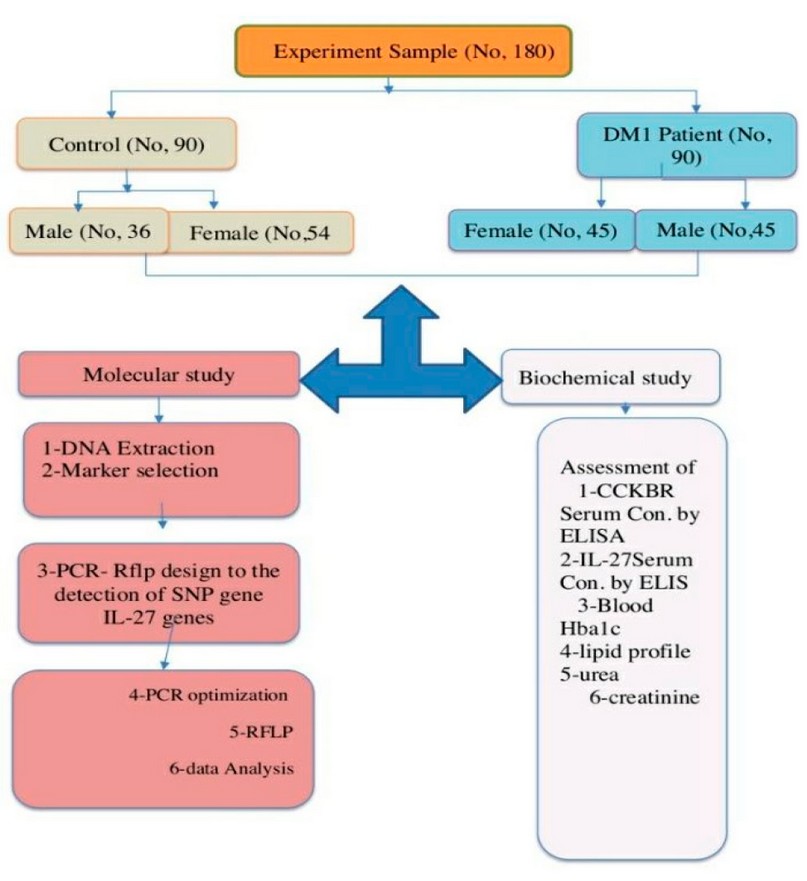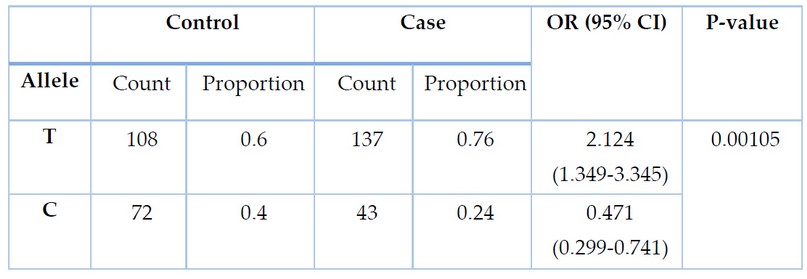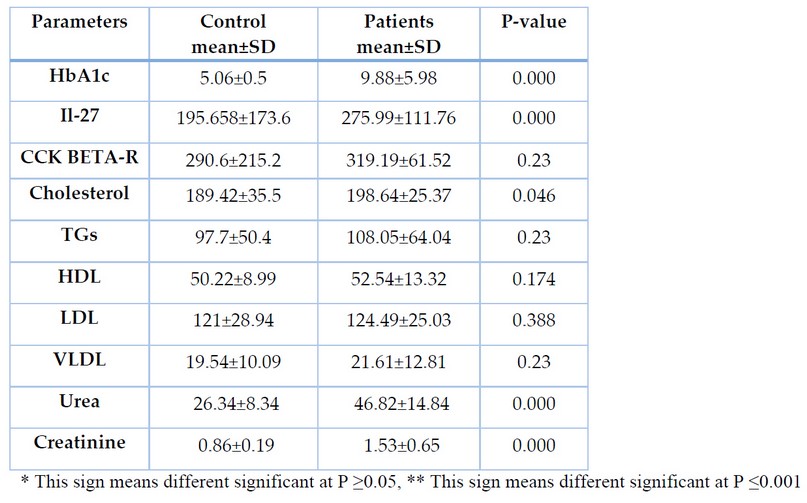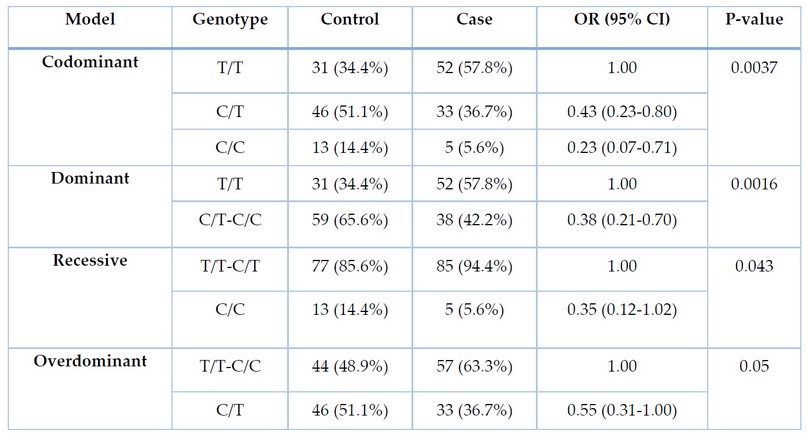2023.08.01.68
Files > Volume 8 > Vol 8 No 1 2023
1 College of Medicine, University of Babylon, Babylon, Iraq; [email protected].
2 College of Medicine, Al-Ameed University, Karbala, Iraq.
3 College of Medicine, Al-Ameed University, Karbala, Iraq.
* Correspondence: [email protected]
Available from: http://dx.doi.org/10.21931/RB/2023.08.01.68
ABSTRACT
Diabetes mellitus (DM) is a central public health problem impacting more than 400 million humhttp://wsx5customurl.comans worldwide. This metabolic disorder progressively drives chronic microvascular, macrovascular and neuropathic life-threatening problems. DM is happened because of a decrease in insulin secretion, harm to pancreatic β cells or insulin resistance connected to the nonuse of insulin. Type – I DM The immune system, by mistake, will attack the β cells of the pancreas, where genes play a vital role. The work was designed to determine the levels of anthropometric variables (age and BMI), immunological parameters (IL-27, IL-27 gene SNP), CCKBR and other biochemical parameters (HbA1C, cholesterol, triglyceride, HDL, LDL, VLDL, urea and creatinine) in sera of T1DM patients. The study contains 180 subjects who are split into two groups; the two groups are the healthy control group and the T1DM patients' group. The result recorded in this research showed a non-significant (p>0.05) difference between the control and patients in age, BMI, CCKBR, TRI, HDL, LDL, and VLDL. A very high significant elevation (P<0.001) has been observed in the level of IL-27, HbA1C, urea and creatinine; there is a highly significant increase (p<0.05) in cholesterol, the gene SNP study shows a significant association of IL27 rs153109 with T1DM was observed under the allele model (OR=2.124, 95% CI (1.349–3.345), P=0.00105), and genotype model in the dominant model (OR=1.00, 95% CI, P=0.0016), recessive model (OR=0.35, 95% CI ( 0.12–1.02), P=0.043) and homozygous model (OR=1.00, 95%, P=0.0037). The study it is cleared that T1DM affects the SNP gene used as a promoter to the excretion of IL-27 and increases its excretion. Lipid profile shows an effect on the level of glucose in the blood, and a high level of cholesterol may cause a severe problem if it is combined with T1DM. The elevated glucose level happens because T1DM affects the renal and causes extreme conditions like renal failure and other renal dysfunction diseases.
Keywords: T1DM, CCKBR, genetic disease, IL-27, IL-27.
INTRODUCTION
Diabetes mellitus Is a severe public health concern that impacts more than 400 million humans around the world, according to the World Health Organization (WHO)1. Chronic microvascular, macrovascular, and neuropathic problems result from this metabolic disorder, which can be life-threatening2. A lack of insulin production, pancreatic cell damage, or insulin resistance due to the nonuse of insulin are all factors contributing to Diabetes mellitus3. Dietary inactivity might be a key contributor to the global increase in diabetes patients, which is expected to reach 366 million in the over-65 population by 2030, according to the World Health Organization (WHO). Diabetes-related complications such as nephron pathy, neuropathy, cardiovascular and renal difficulties, retina pathy, and food-borne infections are just a few of the issues that might arise4 (T1DM) is a form of Diabetes that affects the pancreas. Although it only happens for around 10% of diabetic cases worldwide, it is becoming more frequent much earlier in life5. It is believed that T1DM is caused by the immune system attacking and killing endocrine pancreatic cells6. There is a minimum ratio of patients (10%) who are categorized as type 1B, which means they have no evidence of autoimmunity, and the pathophysiology is considered idiopathic in these cases; this thorough study's goal has always been to present the most up-to-date knowledge on the pathophysiology of type 1 diabetes7. The main factors that affect T1DM are the genetic, environmental, and immunologic factors that contribute to the destruction of endocrine pancreas cells and the development of insulin resistance. Interleukin 27 (IL-27) is a group of the IL-12 family of cytokines with proclaimed pro- and anti-inflammatory effects. It is a heterogeneous cytokine that takes the shape of two special genes. RA patients and examined the clinical significance of these variations. IL-27 is a key role of a cellular agent that adjusts the differentiation of CD4+ T cells, which can execute interleukin-10 and interleukin-17 in vivo. The IL-27 gene has five exons and is found on chromosome 16p118. These polymorphisms were recently linked to several illnesses; inflammatory illnesses like ulcerative colitis, pulmonary, chronic obstructive disease (COPD), and rheumatoid arthritis have been linked to the rs153109 (964 A > G) polymorphism, T lymphocytes attack insulin-producing pancreatic b cells, causing type 1 diabetes. The p28 subunit is encoded by IL27 and has been linked to T1D in humans by many genome-wide association studies9. The T1D risk allele of the SNP rs4788084 was connected with the raised expression of GBP4 and STAT1 in human blood mononuclear cells (PBMCs). cholecystokinin is a peptide hormone linked to the GI system10. Endocrine cells create and release cholecystokinin ( pancreozymin) in the duodenum, the first section of the small intestine11. It is an appetite suppressant and stimulates the pancreas and gallbladder to produce digestive enzymes and bile. The receptors are found in the hippocampus, cerebral cortex, and striatum12. It's in the nuclei of solitary tracts and the lower area of the brain stem13. Tissue and development-specific CCK EPC expression are biphasic, falling just before delivery and rising immediately after 14. CCK-producing neurons number in the human brain increase with age15. The pituitary corticotrophs and spermatogenic cells all have low levels of CCK; CCK-1 and 2 are G-protein-coupled receptors of class 116. The smooth muscles, major cells, and gallbladder D cells have CCK1R (84). In the stomach (parietal, chief, and ECL cells of the gastric mucus), human pancreas, and specific parts of the central and peripheral neurological systems, CCK2R/GR are detected, whereas CCK1R/GR are present (CNS). Cholecystokinin receptors CCK and gastrin bind to CCK receptors, G protein-coupled receptors that bind the peptide hormones CCK and gastrin17.The CCKA and CCKB subtypes are 50% identical; there are two types of CCKR; the first is CCK-A receptors. Physiological CCK-AR stimulation induces exocrine pancreatic enzyme secretion and endocrine pancreatic polypeptide secretion18. CCK-AR limits acid secretion by releasing pepsin from primary gastric cells and somatic statin from gastric mucus D cells19. A decrease in small bowel passage time and a rise in colonic passage time are all caused by CCK-AR on smooth muscle cells, and the second is the anterior nucleus accumbens CCK-BR inhibits dopamine release. Anxiety is regulated by central and peripheral CCK, possibly through interactions with other co-localizing neurotransmitters like aminobutyric acid and 5-hydroxy tryptamine20. CCK-BR is present in monocytes and T lymphocytes, although its function is unknown21. A human leiomyoma sarcoma and the AR42J cell line contain CCK-BR, which may promote proliferation. This work aims to find the connection between CCKRB and IL-27 with T1DM and study the effect of the IL-27 gene on the intensity of the disease.
MATERIALS AND METHODS
Groups Division
Ninety people with type 1 DM enrolled in the study, all of them were diagnosed with no other diseases, the patient's ages were listed from 5 to 30 years old, and the mean was (16.52 ± 7.575) years. This study was conducted in AL-Marjan Hospital diabetic and endocrine center; ninety healthy people volunteered as the control group, their ages from 5 to 30 years old, and the mean was (15.43 ± 7.312) years, from September 1 2021 to February 2022 Babylon city.
Samples Collection
A plastic syringe was used to pull 8mL of blood from the vein. The blood was divided into two tubes. The First was the EDTA tube, and the second was transferred to a gel tube, after which the serum was separated via way of means of the centrifuge instrument; centrifugation education was 2500 g for 10 min. The manner continues beneath Neath's room temperature. The serum was then divided into 3 Eppendorf tubes and saved in a deep freezer (-20 ºC) till Analysis.
Parameters Analysis
Volunteers were under through anthropometric measurements at the beginning, which included waist, height, and weight measurements. Serums of each sample were running under both ELISA technology to get the levels of CCKBR and IL-27, as well as genetic analysis techniques such as PCR and RFLP-technique to detect the target gene (SNP gene) and also used molecular absorption technology to analyze serum triglyceride, cholesterol, HDL, LDL, VLDL, creatinine, and urea concentrations, were HbA1C has been done in EDTA tube by the use of Cobas C111 chemoluminescence.

Figure 1. Experiment design.
Statistical Analysis
Statistical Analysis of the data has been accomplished by using SPSS statistics. The descriptive statistics for each parameter consisted of the mean and (SD). The T-test was utilized to match the chemical variables among patients and control groups at the probability level (P ≤ 0.05)22.
RESULTS
The results were studied by mean ± SD, which counted as significant at P≤0.05 and non-significant (P>0.05) for the age through the two sets. There is a non-significant (p>0.05) change among control and patients with T1DM in age and BMI, as shown in table 1.

Table 1. Age and BMI of study groups
Allele frequencies of the g.-964A > G SNP of IL-27p28 in T1DM patients were significantly different from those in the control group; the T allele increased dramatically in patients as compared with the control and the C allele decreased in patients as compared with the control

Table 2. SNP gene rs153109 analysis.
Table 3 shows a very high significant rise (P<0.001) in IL-27, urea, creatinine and HbA1C. Besides, a highly significant increase (p<0,05) was observed in the cholesterol parameter. In contrast, no significant (p> 0.05) difference exists in the CCKBR, Tri, HDL, LDL, and VLDL study.

Table 3. Parameters of the study
The study of the gene model of SNP gene rs153109 shows a statistically significant change among T1DM patients and controls in both genotype distribution (P=0.0016) and allele frequencies of rs153109 (P=0.00105) (197). The ORs of the associations of rs153109 of IL27 gene with T1DM before and after adjusting for confounders (age and gender).

Table 4.Genotyping Analysis.
DISCUSSION
The result obtained from the previous study shows that there is a rise in the level of HbA1C in the patient as compared with the control, and this is due to the rise in the level of glucose in the blood, so the glucose conjugated in hemoglobin is elevated after a period of disease 23. Moreover, the Level of IL-27 is rising too in the patients, which could show that the immune system is responding to the effect of T1DM in the body. IL-27 is a magnificent cytokine at the same time as it can exert awesome roles: one as an initiator and the alternative as an attenuator of immune responses, IL-27 from myeloid cells and IL-27 signaling in T cells is crucial for T1D development 24, IL-27 without delay alters the stability of regulatory T cells (Tregs) and T helper 1 (Th1) cells in pancreatic islets, which in flip modulates the diabetogenic interest of CD8 T cells. IL-27 additionally, without delay, complements the effector characteristic of CD8 T cells inside pancreatic islets 25. Cholesterol was significantly (P<0.05) higher in T1DM patients' serum than in healthy control subjects. The reason for high cholesterol levels in patients with T1DM due to Type1 DM has emerged as one of the maximum not unusual place reasons for dyslipidemia; vascular headaches are believed to be essential for the diagnosis of DM, and their development, in turn, is thought to rely upon numerous elements along with duration, diploma of control, and dyslipidemia in diabetes 26. Urea and creatinine levels are elevated in patients compared to management. It is back to Diabetes mellitus because it is a slow cumulative disease recognized by hyperglycemia. After a time, a rise in the level of blood glucose causes harm to millions of nephrons 27. As a result, kidneys can't control the electrolyte and fluid homeostasis. The glomerulus filters creatinine; because of that, serum creatinine levels are utilized to read the glomerular filtrations indirectly. When the glomerular filtration rate (GFR) minimize, there is an increase in serum urea and creatinine. In addition, the growth signalizes the gradual kidney disorder, and serum creatinine determination has a higher predictive capacity than urea to predict adverse outcomes 28. The genetic study of IL-27 gene SNP shows that the evaluated T allele as compared with the C allele in rs153109, but it is not significant for this genotype frequencies.
The current study is the first work associated with IL27 polymorphism related to T1DM and CCKBR relationship predisposition. Our results suggest that these polymorphisms may correlate with susceptibility to autoimmune responses with the improvement of modernistic medicine 29. It is commonly believed that interactions among surroundings and genes play an essential function in the pathogenesis of T1DM. Although many genes were mentioned to be related to the susceptibility of T1DM, there may be no well-identified record to date 30. The polymorphisms of the IL27 gene have been considerably studied in many autoimmune sicknesses attributable to IL27, a critical cytokine mediating among the innate and adaptive immune systems. As all of us know, Type 1 diabetes results from an autoimmune response to proteins of the islets cells of the pancreas 31. The autoimmune damage of pancreatic β-cells ends in a deficiency of insulin excretion which ends up inside the metabolic rearrangements related to IDDM. In addition to the lack of insulin secretion, the characteristic of pancreatic α-cells is likewise atypical and there's the immoderate secretion of glucagon in IDDM patients.
CONCLUSIONS
In the conclusion of this research, the study is clear that T1DM affects the SNP gene used as a promoter to the excretion of IL-27 and increases its excretion. Lipid profile shows an effect on the sugar ratio in the blood, and a high amount of cholesterol may cause a severe problem if combined with T1DM; the elevated glucose level happens because T1DM affects renal and cause serious conditions like renal failure and other renal dysfunction diseases. This is the primary identity of the affiliation of the IL27rs153109 gene with T1DM and the relation between CCKBR, lipid profile, urea and creatinine.
Funding: Self-funded.
Competing interests
The authors have not declared any conflict of interest.
Ethical consideration
Ethical issues (including plagiarism, consent to publication, misconduct, data fabrication and/or falsification, double publication and/or submission, and redundancy) were verified by all authors.
Authors Contribution
Conceptualization, MEA and YRA; methodology, NRM and MEA.; software, YRA; validation, NRM, MRA and YRA.; formal analysis, MEA; investigation, NRM; resources, NRM; data curation, NRM; writing—original draft preparation, NRM; writing—review and editing, MEA; visualization, MEA; supervision, NRM; project administration, YRA; funding acquisition, NRM. All authors have read and agreed to the published version of the manuscript.
Acknowledgments
The authors thank the University of Babylon College of Medicine Department of Chemistry and Biochemistry for the easement of the research approach. To all the diabetic patients who participated in this study, Special thanks to the staff of Marjan Medical City, where the study was conducted.
REFERENCES
1. Khursheed R, Singh SK, Wadhwa S, Kapoor B, Gulati M, Kumar R, et al. Treatment strategies against Diabetes: Success so far and challenges ahead. 2019; 862:172625.
2. Wong CY, Al-Salami H, Dass CRJJocr. Potential of insulin nanoparticle formulations for oral delivery and diabetes treatment. 2017; 264:247-75.
3. Chaudhury A, Duvoor C, Reddy Dendi V, Kraleti S, Chada A, Ravilla R, et al. Clinical review of antidiabetic drugs: implications for type 2 diabetes mellitus management. Front Endocrinol 8: 6. 2017.
4. Feingold KRJE. Oral and Injectable (Non-Insulin) Pharmacological Agents for the Treatment of Type 2 Diabetes. 2021.
5. Paschou SA, Papadopoulou-Marketou N, Chrousos GP, Kanaka-Gantenbein CJEc. On type 1 diabetes mellitus pathogenesis. 2018;7(1): R38-R46.
6. Papatheodorou K, Banach M, Bekiari E, Rizzo M, Edmonds MJJodr. Complications of diabetes 2017. Hindawi; 2018.
7. Størling J, Pociot FJG. Type 1 diabetes candidate genes linked to pancreatic islet cell inflammation and beta-cell apoptosis. 2017;8(2):72.
8. Gholijani N, Daryabor G, Kalantar K, Yazdani M-R, Shenavandeh S, Zahed M, et al. Interleukin-27 gene variant rs153109 is associated with enhanced cytokine serum levels and susceptibility to Behçet's disease in the Iranian population. 2020;31(4):140-6.
9. Pang H, Luo S, Huang G, Xia Y, Xie Z, Zhou ZJFiE. Advances in knowledge of candidate genes acting at the beta-cell level in the pathogenesis of T1DM. 2020; 11:119.
10. Kim HT, de Souza AH, Umhoefer H, Han J, Anzia L, Sacotte SJ, et al. Cholecystokinin Suppresses β-Cell Apoptosis, Including in Human Islets in a Transplant Model. 2021.
11. Zeng Z, Ma C, Chen K, Jiang M, Vasu R, Liu R, et al. Roles of G Protein-Coupled Receptors (GPCRs) in Gastrointestinal Cancers: Focus on Sphingosine 1-Shosphate Receptors, Angiotensin II Receptors, and Estrogen-Related GPCRs. 2021;10(11):2988.
12. Ahn S-H, Seo D-W, Ko Y-K, Sung D-S, Bae G-U, Yoon J-W, et al. NO/cGMP pathway is involved in exocrine secretion from rat pancreatic acinar cells. 1998;21(6):657-63.
13. Mobbs J, Belousoff MJ, Harikumar KG, Piper SJ, Xu X, Furness SG, et al. Structures of the human cholecystokinin 1 (CCK1) receptor bound to Gs and Gq mimetic proteins: insight into mechanisms of G protein selectivity. 2021.
14. Najim, Y. S., Mohammed, Th. T. & Al-Khalani, F. M. H. The effect of the use of different levels of Azolla to male broilers diets in the production and physiological performance and economic feasibility. Biochemical and Cellular Archives. 2020, 20(1): 573-580. Doi: 10.35124/bca.2020.20.1.573.
15. Khudair, M.Y Alyassein, R.N, Jasim, F.M. Improving the Quality of Ground Water in Some Areas of Al-Anbar Governorate by Recharging with Rainwater. IOP Conference Series: Earth and Environmental Science.2021, 761(1), 012009.
16. Duan S, Rico K, Merchant JLJF. Gastrin: From physiology to gastrointestinal malignancies. 2022;3(1): zqab062.
17. Beinfeld M, Chen Q, Gao F, Liddle RA, Miller LJ, Rehfeld JJIBGtPC. Cholecystokinin receptors (version 2019.4) in the IUPHAR/BPS Guide to Pharmacology Database. 2019;2019(4)
18. Zeng Q, Ou L, Wang W, Guo D-YJFiE. Gastrin, cholecystokinin, signaling, and biological activities in cellular processes. 2020; 11:112.
19. Kowalski CW, Lindberg JE, Fowler DK, Simasko SM, Peters JHJAJoP-CP. Contributing mechanisms underlying desensitization of cholecystokinin-induced activation of primary nodose ganglia neurons. 2020;318(4):C787-C96.
20. May A. A., Liu M, Woods SC, Begg DPJP, behavior. CCK increases the transport of insulin into the brain. 2016; 165:392-7.
21. Raddam QN, Hadi OHJIJoPHR, Development. Evaluation of the Antioxidant Levels and HbA1c of Type 2 Diabetes Patients. 2020;11(2).
22. He J, Zhang Q, Zhang W, Chen F, Zhao T, Lin Y, et al. The interleukin-27-964A> G polymorphism enhances sepsis-induced inflammatory responses and confers susceptibility to the development of sepsis. 2018;22(1):1-15.
23. Dominguez-Villar M, Hafler DAJNi. Regulatory T cells in autoimmune disease. 2018;19(7):665-73.
24. Castoldi A, Monteiro LB, van Teijlingen Bakker N, Sanin DE, Rana N, Corrado M, et al., Triacylglycerol synthesis enhances macrophage inflammatory function. 2020;11(1):1-11.
25. Sui X, Wang K, Gluchowski NL, Elliott SD, Liao M, Walther TC, et al. Structure and catalytic mechanism of a human triacylglycerol-synthesis enzyme. 2020;581(7808):323-8.
26. Abd, M.Y., Kzar, H.H., Murad, M.M. Assessment of alpha ketoglutarate dependent dioxygenase levels in different genotypes of ALKBH9 gene in patients with T2DM in Babylon province. Indian Journal of Public Health Research and Development, 2019, 10(10). 2125–2130.
27. Z. Al-Fayyadh, D. .; Hasson, A. A. .; Hussein, A. K. .; Hassan, R. K. Effect Of Humic Acid Spray On Growth Characteristics Of Wheat Varieties . Journal of Life Science and Applied Research. 2020, 1, 10-19.
28. Barac IS, Iancu M, Văcăraș V, Cozma A, Negrean V, Sâmpelean D, et al. Potential Contribution of IL-27 and IL-23 Gene Polymorphisms to Multiple Sclerosis Susceptibility: An Association Analysis at Genotype and Haplotype Level. 2021;11(1):37.
29. Hobi, A. A. .; AL-Helal, A. . Effect Of Alcoholic Extract Of Opuntia Ficus Indica On Semen Quality Of Awassi Rams After Different Cooling Periods. ). Journal of Life Science and Applied Research. 2021, 2, 9-13..
30. Couch BA, Wright CD, Freeman S, Knight JK, Semsar K, Smith MK, et al. GenBio-MAPS: A programmatic assessment to measure student understanding of vision and change core concepts across general biology programs. 2019;18(1):ar1.
31. Elkhatib SK, Case AJJPr. Autonomic regulation of T-lymphocytes: Implications in cardiovascular disease. 2019; 146:104293
Received: January 15, 2023 / Accepted: February 25, 2023 / Published:15 March 2023
Citation: AL-Musawi N R, Al-Gazally M E, AL-Saffar Y R.. Investigation of the cholecystokinin-beta receptor, IL-27, IL-27, gene SNP and some biochemical parameters in patients with type-1 diabetes mellitus.
Revis Bionatura 2023;8 (1) 68. http://dx.doi.org/10.21931/RB/2023.08.01.68
